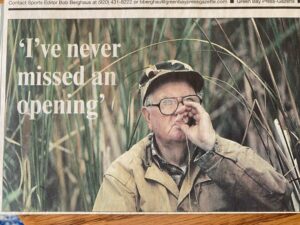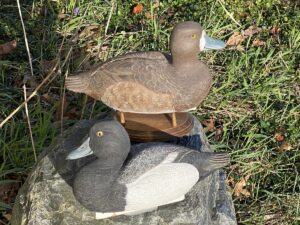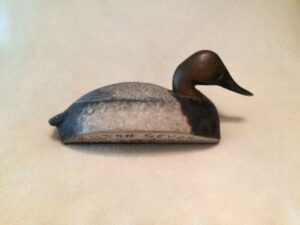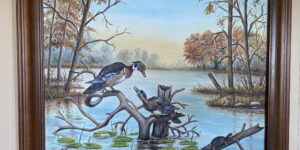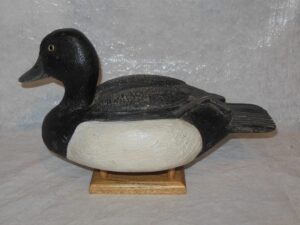A Decoy Corner Article
By Bruce Urben, WWA President
All photos courtesy Wisconsin Sporting Collectibles.
It seems that people all over the world know of Green Bay, Wisconsin, mainly because of the Green Bay Packers. But to those that hunt and fish, Green Bay is also known as a outdoor paradise. I know first hand that the waterfowl migration on the Bay of Green Bay is spectacular in the fall, with hundreds of thousands of ducks and geese staging on the Bay before moving south. And, we are told that the next world record musky will probably come from the Bay of Green Bay!
One carver has lived his whole life in Green Bay and fits the mold of hunter, fisherman, conservationist and… was regarded as an exceptional decoy carver.
Milton Geyer was born on January 15th, 1912 to his parents, Jack and Margarett Geyer. Milton’s great grandparents were German immigrants. Milton had 15 siblings in his family and started hunting waterfowl on the Bay of Green Bay with his brothers at a very young age. Milton began carving decoys in the late 1920’s to satisfy his need for hunting blocks because commercial decoys at the time were expensive and any extra income was spent on feeding the family. During the Depression, all of the siblings were expected to help feed the family and Milton and his brothers did just that with fresh ducks and geese.
Milton was married in 1946 and had two children. He worked at Baywest paper company in Green Bay and worked there most of his life until he retired in 1976. In his later years, Milt hunted ducks every chance he had with his hunting partner (and fellow carver), Ted Thyrion. At one time Milt was quoted that he had never missed and opening day of duck season!
Milton continued to carve decoys and became quite good at providing life-like details to his blocks. Friends and area sportsmen were quick to order decoys from Milton at a fair price. It was reported that Milt could carve a decoy in one day and then take an additional day to burn feathers and paint each one. Milton had his decoys for sale in local Green Bay sport shops and was a regular at local decoy shows, where his inventory quickly sold out every time.
Milton carved solid wood decoys and provided exceptional detail in his bill and feather carving. He used cedar, cork and basswood for his carvings, but really relied on old telephone poles for his bodies. All of his decoys were fitted with glass eyes. He was an expert at painting; he used shading and blending with his oil paint to give lifelike appearance to his decoys.
Geyer primarily carved canvasback, bluebills and mallards, but also made some redheads, black ducks, coot, teal, mergansers and loons! His early decoys were oversized, but later were more life sized. In addition to decoy carving, Milton was an accomplished wildlife scene artist, painting numerous depictions of waterfowl on the Bay of Green Bay. He was a member of Ducks Unlimited, a lifetime member of the Green Bay Duck Hunters Association and donated numerous decoys and paintings to local conservation organizations.
Milton’s decoys are in high demand by Wisconsin collectors and sometimes can be found on the secondary auction market. Many are in great condition and command top dollar! I wish I could say that I have a Milton Geyer decoy, but the best I can do is enjoy a pair of vintage mallard, Mason decoys that were repainted by Milt in 1976!
Milton Geyer passed away in 1996 at the age of 84 and is buried at Nicolet Memorial Garden in… you guessed it, Green Bay, WI.

